This was published 8 years ago
Okavango Horse Safari camp, Africa: Seeing Botswana on horseback
By Julie Miller
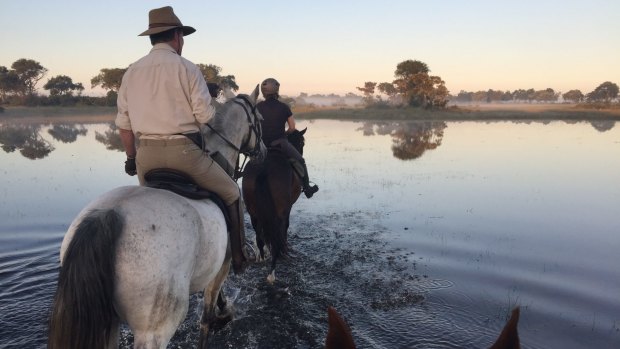
Riding through the Okavango Delta.Credit: Julie Miller
The waters have come early to the Okavango Delta. I snuggle beneath the doona in my comfy safari tent, absorbing nature's chorus: the deafening bass of courting bull frogs, freshly emerged from muddy hibernation; the guffaw of wallowing hippos; and the splash of what I assume to be elephants at play.
Suddenly I hear a guttural rumble and the creak of branches snapping on approach. I peer into the dark as an enormous black form looms, pausing just metres from my tent, moonlight glinting on metre-long tusks. I start to tremble, subconsciously shuffling deeper into my bedding as the bull elephant sways in contemplation, before ducking beneath a branch and continuing his crash course through the foliage. Exhale.
It's only my first night at the Okavango Horse Safari camp, but already the scene has been set for the most mind-blowing week of my travelling career. In the coming days, I will experience wildlife encounters that will leave me gasping in awe, shaking with terror and tingling with excitement. And it will all be savoured from my favourite place in the world – on the back of a horse.
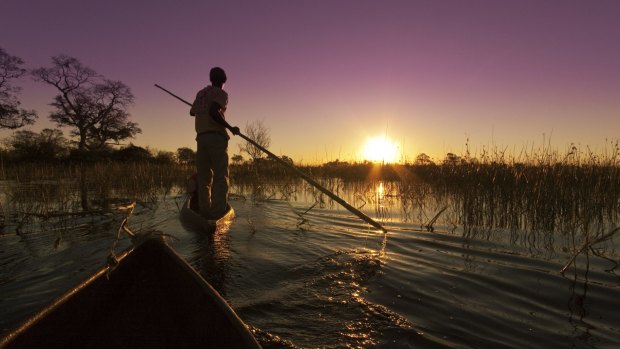
Traditional canoes traverse the wetlands in Okavango, Botswana.Credit: MB Photography
This is my second visit to this real-life movie set: the first was 11 years ago, prior to the Delta's annual inundation by creeping floodwaters. Then, the grass was long and golden, the ground parched, and hungry game were concentrated around drying waterholes.
I realise I'm in for a very different experience this time. After recent heavy rainfall, the flood has rapidly engulfed the plains, literally turning meadows into lakes. There's an air of anticipation, of new life, rejuvenation.
There are 60-odd horses in Okavango Horse Safari's string; some are the homebred progeny of an American Saddlebred stud, while others - such as Mahale, the show-winning Arabian gelding I'm riding - are imported from South Africa or Zimbabwe.
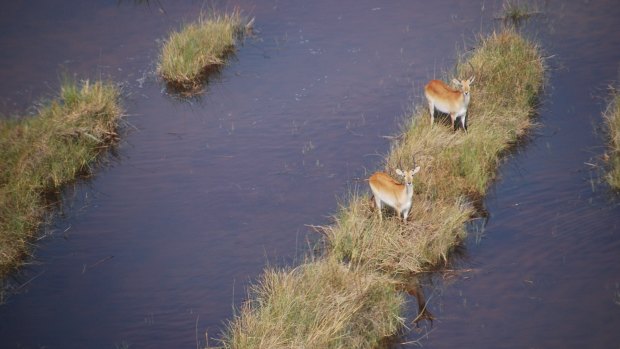
Game graze by the Okavango.Credit: Julie Miller
The logistics of keeping horses in this hostile environment are staggering: hard feed is trucked in monthly, vets make annual pilgrimages from the UK, while a night watchman is employed to guard the stables from marauding lions. It's testament to owners PJ and Barney Bestelink's exceptional equine husbandry skills that their horses are healthy and well-behaved.
Located in the northwest of Botswana, the Okavango Delta is one of the world's biggest inland alluvial fans, its waters rising in Angola before trickling south, watery tendrils spreading into a maze of lagoons, islands and channels covering an area of around 13,000 square kilometres. This annual miracle occurs between April and October, the waters gradually receding before being absorbed by the dry air and thirsty sands of the Kalahari basin.
One of the Seven Natural Wonders of Africa and declared the 1000th World Heritage site by UNESCO in 2014, this veritable Garden of Eden supports the largest and most diverse population of wildlife in Botswana, with exceptional game viewing guaranteed on any safari. Add the challenge of horse riding into the mix and you have one of the most exciting adventure experiences on the planet.
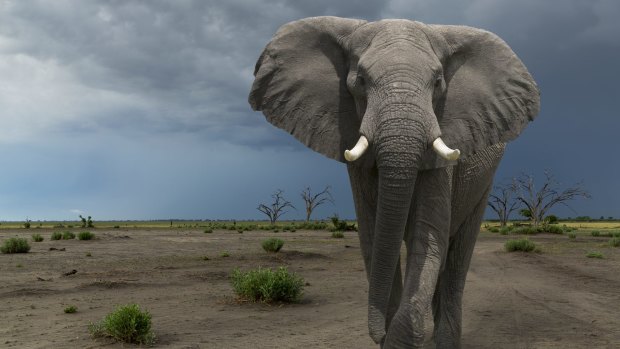
An elephant roams the Okavango Delta area in Botswana.Credit: Buena Vista Images
In the saddle, you are a participant in the environment, part of the landscape and at one with the wildlife. The horse is not a threat to other herd animals. If the approach is relaxed, you can mingle happily in their midst. Allowing your horse to graze is an indication that all is well with the world; silence from the riders is crucial.
Our guide Rogers – a native of the Delta and a staff member for 23 years – is able to spot game at impossible distances. What appears as a shadow on the horizon is in fact a lone elephant; a log on a bank is a crocodile; and a rock under a tree, a wiry warthog, tail waggling comically in the air. Sign language is used to indicate what he has seen, the signal passed silently down the line. Rogers then chooses his approach carefully, circling upwind so the animals cannot smell our presence.
Luck is with us on our first outing. Within minutes of leaving camp, we stumble across a pack of endangered African wild dogs lying in the grass. Bellies full after a recent kill, they seem unperturbed by our presence, allowing us to creep within metres. Rogers informs us there are only around 3000 to 5000 African wild dogs remaining in the wild, making this a rare treat indeed.
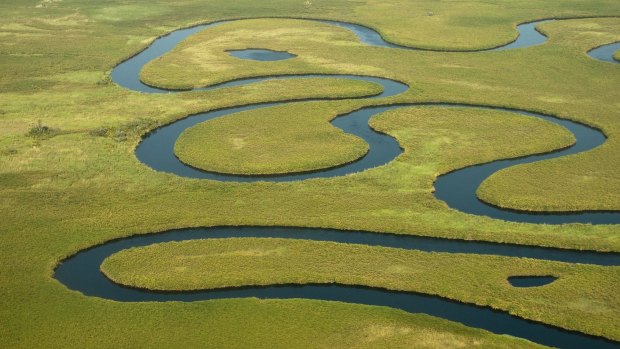
The Okavango river in Botswana.Credit: Cedric Favero
Rogers is also a body language expert. Any sign of discomfort or aggression from the wildlife is immediately acknowledged, with retreat the safest option. A graceful mother giraffe allows us to canter alongside her one-month-old baby before gathering her doe-eyed offspring close and turning her back.
A pair of bull elephants squint at us warily for several minutes before raising their trunks to indicate enough is enough. One cranky matriarch, however, is not so accommodating. The large herd of breeding cows and babies scatters on our approach, but granny stands her ground, waving her ears and trumpeting a warning as she turns to face us. We hold firm, calling her bluff momentarily before it becomes clear she means business, charging in our direction with a resounding bellow.
"Go! Go!" we are told, and I swing Mahale around, clamping my legs to his sides. We canter off to safety, then are instructed to stop and once again observe.
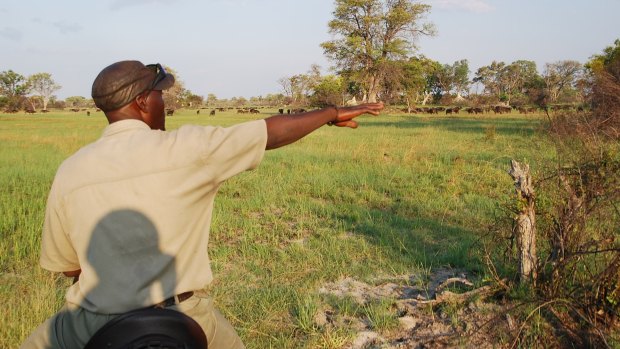
On safari in Okavango, Botswana.Credit: Julie Miller
Still upset, the matriarch has now assembled the troops: before us is a conga line of flapping ears, eight huge female elephants raising their trunks in defiance, marching steadfastly through the stunted mapone forest. It's an incredible display of solidarity and protection, and we have no intention of ignoring their warning. Respect, ladies.
As the oppressive African sun hovers overhead we return to camp for a well-earned siesta. Afternoons are spent dozing, lying by the riverside pool or relaxing in an open-sided treehouse, watching for passing hippos. Later, we pile into a jeep for a sunset safari, enjoying sundowners at a scenic waterhole. The return to camp is rewarded with sightings of a leopard crouching warily in the spotlight, and a bold African wildcat.
Another afternoon is spent paddling through the mirrored wetlands on a mokoro, a traditional dug-out canoe manoeuvred stand-up style by our handsome guides. We pause to watch two hippos snort and grunt in submarine play. The hippo is one of the most dangerous creatures in Africa, and Rogers is at pains to avoid the channels, paddling close to shore in the grasp of the waterlogged reeds. We return to camp as the sun dips over this watery wonderland, absorbing the magic in appreciative silence.
After a 5.30am wake-up call, I am trotting through the mist by 7am, this time astride a stocky homebred crossbreed named Kujwana (meaning 'baby hippo'). Today we are headed to Mokolwane 'fly camp', named after the towering palms that grace the northern realms of the delta. The 30-km ride will take six hours, and Rogers sets a cracking pace.
With such punishing hours in the saddle, ride-fitness is crucial for this adventure, as is the ability to gallop out of danger. Barney and PJ are adamant that only experienced riders embark on their horseback safaris; non-riders are welcome in camp, however, with activities such as walking and jeep safaris, mokoro trips and fishing offered as alternatives.
I can't help but feel sorry for the non-riding guests, though, as we recount our close encounters around the evening campfire, words a poor substitute for the thrill of the moment. How can you describe, for instance, the sensation of galloping alongside a 200-strong herd of stampeding buffalo, dust flying and the thunder of hooves resonating deep in your soul?
Our approach to Mokolwane presents another challenge - the only way to get the horses across the flooded channel is to swim. Removing saddle, boots and helmets, we are given instructions on how best to assist our mounts – by doing nothing but hanging on, allowing them to complete the task at hand.
Taking care to follow in Rogers' exact steps, I ease Kujwana off the grassy bank. A boat is on standby in case we fall, having already buzzed the crossing to ward off crocs and hippos; but as the water creeps up my bare thighs, I scan the water with trepidation, looking for telltale bubbles.
Kujwana is working overtime, legs scrambling as he struggles for footing. I cling to his tangled mane, giving him free rein, and for a split second, I float above his back, weightless in the current. I squeal with delight, enjoying the sensation of the cooling water, the urgency of my horse's passage, before once again he connects with solid ground, hauling himself to shore with a satisfied shake.
As we ride bareback into camp, I marvel at my horse's strength, his level-headedness and bravery under such extreme circumstances. I reach forward and rub him between the ears, a small token of my appreciation, for my happiness and safety.
Kujwana just snorts, and tugs at the reins to snatch at a passing clump of grass. All in a day's work for an Okavango horse.
THE FIVE MOST DANGEROUS ANIMALS TO ENCOUNTER ON A HORSE
1. LION Not a word you want to hear while you're on a horse. But it happens. The advice is to stay in a group and walk off slowly at an angle. If you guide says "go", you go – fast. Do not try to stop your horse.
2. BUFFALO It's the single males you need to worry about, as they are grumpy and aggressive. At the slightest sign of irritation, be on your way.
3. ELEPHANT Breeding herd matriarchs tend to be more aggressive than single bulls, as they have more to protect. Look for trunk waving and ear flapping as signs.
4. HIPPOS They are fine if they are in the water (and you aren't) – but never get between a grazing hippo and the water. Also beware of surfacing hippos as you swim your horse across a channel.
5. REED BUCK This innocent little antelope pops out of long reeds at the most inopportune time, causing even the bravest horse to spook. Most annoying.
TRIP NOTES
MORE INFORMATION
GETTING THERE
South African Airways has daily flights from Perth to Johannesburg, with code-share connections from Sydney and Melbourne with Virgin Australia. From Johannesburg there are daily flights with either Air Botswana or South African Airways. See www.flysaa.com and www.virginaustralia.com
STAYING THERE
A six-day Okavango Horse Back Safari costs $7320 per person twin share, including meals, drinks, riding, game drives, walks and mokoro safaris, plus a fixed wing and helicopter return transfer from Maun; see www.okavangohorse.com
The writer was a guest of Bench International and Okavango Horse Safaris.
Sign up for the Traveller Deals newsletter
Get exclusive travel deals delivered straight to your inbox. Sign up now.